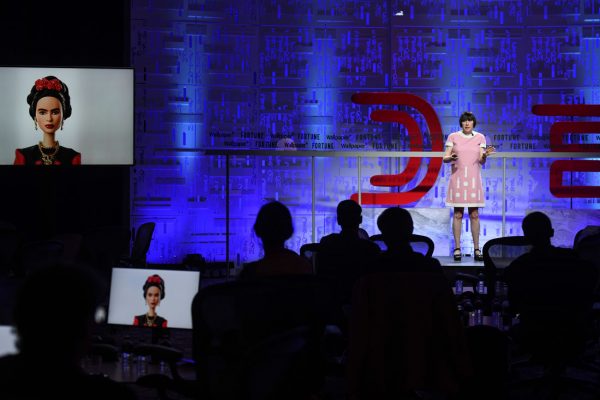British design critic and author Alice Rawsthorn talked more about bad design at Brainstorm Design Conference. Her updated categories included examples from Mattel, Adidas, Burberry and Nokia.

May 3rd, 2019
“I’m going to be the party pooper,” said Alice Rawsthorn at the start of her Brainstorm Design session on March during the Singapore Design Week 2019. “Instead of telling you about these glorious design success stories, I’m going to talk about a couple of flops and failures.”
She posited that we tend to ignore bad designs in talks, podcasts and publications – a mistake since bad designs are abundant in our lives and have just as much, if not more, impact on us because of the resources (time, money, emotion, energy, effort) that we ultimately need to pay to deal with the damages.

Alice Rawsthorn at Brainstorm Design Conference
It was the second time Rawsthorn talked about bad design at the conference. Her delightful session last year talked about six categories of bad design. This year, she expanded the categories and updated the examples from each one in a session titled 7 Categories of Bad Design.
“It’s by no means an exhaustive list, but it should give you an idea and a cautionary warning of what can happen when design goes wrong,” said Rawsthorn. And the seven categories are:
“These are the design projects that simply fail to fulfil their functions efficiently,” said Rawsthorn.
The example? The ‘Boris Bus’ – the red double-decker bus launched in 2012 by the then-Mayor of London Boris Johnson. The bus, a sleek redesign of London’s iconic Routemaster double-decker bus by Thomas Heatherwick, was meant to be the new icon of the city.
They look rather good, she said, thanks to Heatherwick Studio’s interior and bodywork. The problem was the lousy quality of design engineering. The busses broke down frequently, their batteries stall often, which necessitated the switch to diesel machine that’s damaging to the environment. They are also prone to overheat, which earned them another nickname: the Roastmaster.
Rawsthorne described this category as the kind of projects that can fulfil its function efficiently and yet still badly designed because that function isn’t something we value. An example would be the recently launched Nokia 9 smartphone, which boasts five cameras. “I’m sorry but who needs five cameras in their phone?” she quipped.

Alice Rawsthorn at Brainstorm Design 2019
“This category refers to design projects whose designers obviously haven’t thought rigorously enough about their consequences,” sais Rawsthorne, citing the Agbogbloshie Scrapyard, the gadget dumping ground outside of Accra in Ghana, as the prime example.
Here, thousands of products manufactured outside of the country have been poisoning the ground. Designers need to take more care of the recyclability of the products.
A case in point was the wire copper in electronic products, which is recyclable and quite valuable, but often end up in Agbogbloshie because the recycling plant was unable to detect the copper because it was encased in black rubber – a bad, irresponsible design that can be avoided with more a thoughtful design process.
The case study for this category was Adidas’ specially designed 2010 World Cup football Jabulani. Launched to commemorate the event and to ensure a fair, more dynamic and more exciting games, Jabulani behaved differently in different altitude (some host cities, like Capetown and Johannesburg, vastly different altitudes) – every goalie’s nightmare.
These are design projects that are, said Rawsthorn, “Admirably conceived but gone horribly awry.” She shared two case studies from this category, courtesy of IBM and Mattel.
The former created a campaign to attract more female talent to the tech industry that included a very patronising and generally sexist hack-a-hairdryer event. The campaign was rightfully called out and ridiculed.

Frida Kahlo Barbie on screen at Brainstorm Design
The later celebrated International Women’s day in 2018 by launching a Frida Kahlo Barbie doll with an intent to highlight Kahlo’s uniqueness and refusal to conform to the western beauty standard as something to admire and aspire to.
But the doll’s design did away with her signature unibrow and Tijuana dress. Her look was so Europeanised that it prompted Kahlo’s estate to sue the company. The dolls were withdrawn from the stores.
The fashion industry is the biggest offender in this category. These are design projects whose design intention that even Rawsthorne couldn’t fathom. And most often, these bad design projects are associated with racist imagery (this is why diversity in a design team is important).
Cases in point were Gucci’s ill-conceived blackface balaclava sweater and Burberry’s hoodie with a noose, both debuted (and subsequently pulled from production) at its respective brand’s Fall 2019 runway presentations recently.
Did you know that women are 40 per cent more likely to sustain an injury in a car accident than men? The primary cause of this is believed to the design of the crash test dummies used to test the vehicles. These dummies were modelled after a typical male body, leading to data that is not as universal for female body types and male body types that don’t conform to the dummy’s form.
Another example Rawsthorn shared was the algorithm used by the United State’s Justice Department to identify faces. This software has been found to be biased and more likely to correctly identify while male than others, leading to a world of grief caused by a mistaken identity for others.
INDESIGN is on instagram
Follow @indesignlive
A searchable and comprehensive guide for specifying leading products and their suppliers
Keep up to date with the latest and greatest from our industry BFF's!

In design, the concept of absence is particularly powerful – it’s the abundant potential of deliberate non-presence that amplifies the impact of what is. And it is this realm of sophisticated subtraction that Gaggenau’s Dishwasher 400 Series so generously – and quietly – occupies.

Within the intimate confines of compact living, where space is at a premium, efficiency is critical and dining out often trumps home cooking, Gaggenau’s 400 Series Culinary Drawer proves that limited space can, in fact, unlock unlimited culinary possibilities.

In this candid interview, the culinary mastermind behind Singapore’s Nouri and Appetite talks about food as an act of human connection that transcends borders and accolades, the crucial role of technology in preserving its unifying power, and finding a kindred spirit in Gaggenau’s reverence for tradition and relentless pursuit of innovation.

To honour Chef James Won’s appointment as Gaggenau’s first Malaysian Culinary Partner, we asked the gastronomic luminaire about parallels between Gaggenau’s ethos and his own practice, his multidimensional vision of Modern Malaysian – and how his early experiences of KFC’s accessible, bold flavours influenced his concept of fine dining.
The internet never sleeps! Here's the stuff you might have missed

Practicing architecture and giving back to the next generation of students, Jenchieh Hung of HAS design and research is ensuring that the landscape of Thailand is in very good hands for the future.

This fine-dining restaurant by Studio Dashline comprises a fluid layout that improves social interaction and the overall dining experience.